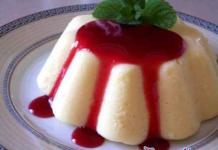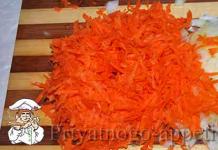Apricots in syrup, a winter recipe that I have been using for many years
Buying fruit preparations in a store is very easy and simple, but sometimes the prices for these small jars of preserves create the feeling that there are “golden berries or fruits” inside. That is why it is better to do your own homemade preparations that will delight you and your family throughout the winter. We also advise you to look at the section on our website: “” where there are many more delicious and interesting recipes for preparations.
Canned apricots can be served as an independent dessert or used for making desserts and baked goods, for filling, etc., there are many options. The main thing is to be patient and have the right apricots! Harvesting apricots is quite simple, it is important to choose the right fruits. Be sure to remember our tips that you will need when choosing fruits:
- Do not buy slightly overripe fruits for canning whole fruits, even if they are ripe on one side and not on the other, refuse this purchase;
- For canning whole fruits, give preference to small fruits;
- To prevent the fruits from bursting during the harvesting process, it is recommended to dip them in a soda solution for several minutes (a teaspoon of soda per liter of water);
- It is important to remember that preparations made from whole apricots, plums and other fruits should be stored for no more than one year!!! Because Amygdalin can be released from the seeds, which can become a real poison during long-term storage.
Well, now, knowing how to choose the right tasty and beautiful fruits, let’s go to the kitchen, create and get a little creative!
Ingredients for apricots in syrup:
- Fresh and strong apricots – 700 kg,
- Granulated sugar – 350 grams,
- Water – 1.5 liters.
Recipe: apricots in syrup for the winter
Sort and wash the fruits. Then put it in a deep cup, prepare a soda solution as described above (1 teaspoon per liter of water). Pour the solution over the fruits and leave for five minutes. Then rinse the apricots again in plenty of cold water.
Arm yourself with a large needle or knitting needle and prick each fruit in several places so that when harvesting each fruit is well saturated with sweet syrup.
Prepare the jars; they should be thoroughly washed with soda or any dishwashing detergent, then sterilized.
Place the prepared fruits in jars. Pour boiling water over it, be careful not to let the boiling water get on the sides of the jar, otherwise it may burst! Leave the fruit in boiling water for 5 - 10 minutes, during which time they will become much softer.
Carefully pour the water back into the pan and add sugar. Place the water on the fire and bring to a boil, stirring occasionally until the sugar dissolves completely. For more aroma and taste, you can add a bag of vanilla or ground cinnamon.
Pour hot syrup into jars of apricots. Roll up with a special key and sterilized tin lids. Turn the jars over and wrap them in a warm blanket. Leave in this state until completely cooled. Store these jars in a cool place.
Not as difficult as it might seem at first glance! Let the process of preparing for the winter become a pleasant pastime for you!

Good luck with your preparations and bon appetit!
In the last article I showed you a simple recipe for apricot jam. Today we will look at how to prepare canned apricots. It will be so great to open these jars in winter and enjoy the unforgettable taste of a bygone summer. To work, we need the same three components: the berries themselves, basil and water. As in the previous recipe, an unexpectedly excellent result awaits us. I invite you to read the description recipe, look photos, which depict all stages of preparation. You will see for yourself that there is nothing complicated here. Suddenly you want to make the same twists from apricots for the winter?
Canned apricots– a great way to preserve as much as possible all the elements in juicy and bright fruits. Pieces of ripe fruit can be used at your discretion. They make excellent desserts. They are suitable for making pies and buns. You can simply put them on a plate and serve them on the holiday table as an independent dessert.

In this recipe, the preserve includes fragrant basil leaves, which makes the dessert more tender and aromatic. To ensure that apricot pieces retain their appearance, it is recommended to use them for harvesting dense but ripe fruits(without flaws and roughness).
Ingredients (per 500 ml):
- apricots (300 grams);
- sugar (150 grams);
- basil (1-2 sprigs).

Canned Apricots Recipe
1. Select suitable fruits and wash them with running water. Divide the apricots into two halves and remove the pits. Place the prepared orange mass into pre-prepared and heated containers - jars. We try to fill 2/3 of the glass container.

2. Add the prepared basil greens to the container. We use spices of any color. If we use red greens, the finished product will take on a darker color.


4. Pour boiling water over it. Fill the entire container with hot water, right up to the neck. Cover the apricots with a lid and heat the preparation in the oven (120 degrees) for 20 minutes. This method of sterilization helps to heat the mass evenly (which minimizes the entry of bacteria into the jar).

5. Seal the hot apricots and basil and turn them over. Cover the jars with a warm blanket and leave for 10-12 hours. We send canned apricots with basil for storage.

As you can see, no special culinary delights. Everything is simple and clear. But in winter, it will be so nice to open jars of homemade canned apricots, serve them at the holiday table, or just enjoy them while sitting in front of the TV, hugging a glass jar.
Fresh apricots spoil quickly, so if you have a lot of them, you might rightly want to save them for long-term storage. Preservation (jaring) is a method that will allow you to achieve this; if done correctly, apricots can be stored for about a year without loss of quality. You can preserve apricots using hot or cold (raw) canning methods. Read on to find out how to prepare them in each of these ways.
Ingredients
Canning for 4.25 l
- 4.5 kg ripe apricots
- 1 liter of water
- 2-3 cups (500-700 ml) sugar OR 1.5-2 cups (375-500 ml) honey
- Diluted lemon juice (optional)
Steps
Hot canning
-
Make a light to medium syrup and use it to preserve fruit inside a jar.
- If you use honey: for light syrup, for every liter of water - 1.5 cups (375 ml) of honey, for medium syrup - 2 cups (500 ml).
- Boil water and sweetener together in a saucepan until the sugar or honey dissolves. Then, reduce the heat until the syrup begins to simmer slowly.
- Alternatively, you can use apple juice or white grape juice instead of syrup.
-
Remove the skin. Quickly remove the skin by blanching the fruit in boiling water.
- Bring water to a boil in a medium saucepan.
- Dip the apricots into it and boil for 2 minutes.
- Quickly transfer the apricots to a bowl of ice water to stop cooking.
- Remove the skin with your fingers.
-
Slice the apricots and quickly dip into the syrup. Using a kitchen knife, cut each apricot in half. Remove the pits and, if desired, cut the apricots into manageable-sized pieces. Place them directly into the still simmering syrup so that they do not have time to lose color or darken.
- Once the apricots are in the syrup, let them warm completely in the boiling water. This should take 2 to 4 minutes.
- To prepare 7 liters of canned apricots you will need 7.2 kg of fruit. For 4.2 l - about 4.5 kg.
-
Fill the jars with apricots. Pour both syrup and apricots into each jar, leaving one and a half centimeters of free space under the jar lid. Screw the lids on, making sure they are held as tightly as possible.
- If possible, place fruit cut side down in jars to accommodate more apricots.
- Don't forget to wash and sterilize the jars first. The lids need to be treated in the same way.
-
Process the jars.
- Half-liter jars need to be processed for 20 minutes at an altitude of 0-300 m above sea level, 25 minutes at an altitude of 300-900 m, 30 minutes at an altitude of 900-1800 m, 35 minutes at an altitude above 1800 m.
- Liter jars need to be processed for 25 minutes at altitudes of 0-300 m above sea level, 30 minutes at altitudes of 300-900 m, 35 minutes between 900 and 1800 m, and 40 minutes at altitudes above 1800 m.
Cold canning
-
Prepare syrup for apricots. Use honey or sugar to make a light to medium syrup that will allow you to preserve the apricots inside the jar. The syrup for raw canning is the same as for hot canning.
- For every liter of water, add 2 cups of sugar (500 ml) for a light syrup, and 3 cups of sugar (750 ml) for a medium syrup.
- If you use honey: for light syrup, for every liter of water - 1.5 cups (375 ml) of honey, for medium - 2 cups (500 ml).
- Boil water and sweetener together in a saucepan until the sugar or honey dissolves. Once the syrup has thickened, remove the pan from the heat.
- Alternatively, you can use apple or white grape juice instead of syrup.
-
Cut the apricots into halves. Using a kitchen knife, cut each apricot in half. Remove the pits and, if desired, cut the apricots into manageable-sized pieces.
- You can briefly dip each apricot half or piece in diluted lemon juice to keep the fruit from losing color and browning.
- To prepare 7 liters of preserves, you will need 7.2 kg of fruit. To prepare 4.2 liters of preserved food – about 4.5 kg of apricots.
- Note that for raw canning you do not need to remove the skin. Just make sure that each piece of fruit is rinsed well under running water first.
-
Place the apricots in a jar. Fill the jar with apricot halves or pieces, leaving about one and a half centimeters of space under the lid of each jar.
- Place the fruit in a jar, cut side down. This will make it easier for you to fit more fruit into the jar.
- Be sure to sterilize each jar. Lids must also be sterilized.
-
Pour the syrup into jars. Pour the syrup into the jar over the apricots. Lightly shake the jar from side to side so that the syrup completely fills the space, reaching the very bottom of the jar. When you pour the syrup, leave one and a half centimeters of free space under the lid of the jar.
- As the apricots are canned, the contents of the jars will expand. If you do not leave enough space under the lid, it may lose its seal or the glass may crack.
- Screw on the lids after pouring the syrup. Make sure they are seated as tightly as possible so that the jars will seal properly throughout the canning process.
-
Process the jars. Using tongs, carefully lower each jar into the pressure cooker. When you arrange the jars, make sure they are not touching each other, otherwise they may burst. You can boil the jars in a saucepan with a special stand (if the glass touches the bottom, it may burst) or do it in a pressure cooker (with dial or weight adjustment), however, the processing time will depend on the method you choose.
- Note that the processing time for cold canning will differ from hot canning if you use a pot of boiling water (with a jar rack), but will remain the same when using pressure cookers.
- If you are using a pan with a trivet and boiling water:
- Half-liter jars need to be processed for 25 minutes at an altitude of 0-300 m above sea level, 30 minutes at an altitude of 300-900 m, 35 minutes at an altitude of 900-1800 m, 40 minutes at an altitude above 1800 m.
- Liter jars need to be processed for 30 minutes at altitudes of 0-300 m above sea level, 35 minutes at altitudes of 300-900 m, 40 minutes between 900 and 1800 m, and 45 minutes at altitudes above 1800 m.
- When using a dial pressure cooker, both half-liter and liter jars need to be cooked for 10 minutes. At an altitude of 0-600 m, set the pressure to 0.42 kg/cm2 (42 kPa, 6 PSI), 600-1200 m - 0.49 kg/cm2 (49 kPa, 7 PSI), 1200-1800 m - 0.56 kg/cm2 (56 kPa, 8 PSI), 1800-2400 m – 0.63 kg/cm2 (63 kPa, 9 PSI).
- If you are using a pressure cooker with weight adjustment, both half-liter and liter jars need to be cooked for 10 minutes. At an altitude of 0-300 m above sea level, use a pressure of 0.35 kg/cm2 (35 kPa, 5 PSI), and at an altitude above 300 m use a pressure of 0.7 kg/cm2 (70 kPa, 10 PSI).
- Fruits that are bright, firm, and fully ripe are best for canning.
- Hot canning is preferable to cold canning because it preserves the quality of the fruit better - you will discover this when you open the can.
- Store canned apricots at temperatures below 27 degrees and keep out of sunlight.
Warnings
- If canned apricots smell bad or have mold on them, throw them away immediately. Wash and sterilize the jar thoroughly before reusing.
Housewives, even on warm summer days, do not have the right to completely relax, because it is at this time of year that nature gives us fresh fruits, vegetables and berries, which we need to have time to process and stock up for the winter.
Housewives especially appreciate various preparations made from apricots. Firstly, thanks to the huge selection of options: canning apricots in syrup, in their own juice, preserves and compotes, jams and much more. Secondly, these are one of those fruits that retain all their beneficial composition even when cooked. Vitamins, as well as a unique aroma - all this remains even after heat treatment.
Preservation: apricot compote
One of the most popular recipes is the preparation of compotes. An aromatic and incredibly tasty drink will give you pleasant, warm memories of summer on harsh, windy winter evenings. There is nothing difficult in preparing this recipe. Even a novice housewife will be able to cope with canning apricots and please her household with a vitamin drink in winter.
The following ingredients will be required:
- Ripe apricots.
- Granulated sugar at the rate of 250 grams per 3 liter jar.
- Water.
How to cook
For cooking, select ripe but still elastic fruits. After washing them thoroughly, you will need to remove the seeds. Of course, this process is quite labor-intensive, especially if you need to process a large number of berries. You can cover the compote with seeds, but then you still have to get rid of them. Therefore, it is better to do this in advance, spending a little of your precious time. The result, believe me, is worth it.

Place the prepared fruits in three-liter jars. Don't overfill the jars. It is enough to put one third of the fruits from the total volume of the container. Pour boiling water into the jar and wait about ten minutes. This time is needed for the jars to warm up thoroughly. Now drain the water from the cans into a pre-prepared saucepan. Add the required amount of sugar there and bring the syrup to a boil.
Pour boiling water into the jars again and close them with lids. It is better if you use metal lids and a special seaming wrench. In this case, preserving apricots for the winter will not present any unpleasant surprises in the form of a blown lid.

Apricot jam with oranges
Another recipe for preserving apricots, which we recommend you focus on, is jam. Of course, modern housewives do not make jam as often as our grandmothers. But those who do this will certainly appreciate the delicious and amazingly aromatic recipe.
Let us immediately note that the result will give you a surprisingly tender, not at all cloying and moderately thick jam. In addition, this recipe for canning apricots has two more significant advantages: no sterilization and no hours of cooking.
The following products will be required:

Process
If for compotes we took strong, dense fruits, then for jam, on the contrary, we choose the ripest, even too soft apricots. We do not accept small or unripe ones, with stains or dents. We wash the fruits and remove the seeds. Using a kitchen assistant - a blender - chop the apricots and turn them into a homogeneous paste. If you don’t have a blender at hand, you can use a regular meat grinder with a fine mesh.
We take two containers. Grate the zest of two oranges into one. Squeeze orange juice into another. Mix gelatin with granulated sugar, calculating its amount based on the available volume of fruit. Add the dry mixture to the pan with the apricot puree. Mix. Turn on medium heat and wait until it boils.
It should be noted that this recipe for canning apricots takes a minimum of time, so you don’t have to worry about being stuck in the kitchen with jam all day. As soon as the mixture boils, time it for three minutes and add the zest and orange juice. After a couple of minutes you can turn on the fire. The jam is ready.
Preserving apricots in slices
Another interesting preparation option. This recipe for apricot jam, called “Solnyshki,” will require more time to prepare, but as a result you will get an amazingly beautiful and amazingly aromatic jam. It will retain a maximum of useful substances, which are sometimes so necessary for our body on cold winter evenings. “Solnyshki” jam can not only be served on a festive table, but also used to make pancakes, pies and pies, cheesecakes and other sweet pastries.
Required ingredients:
- Sugar.
- Apricots.
Add granulated sugar at the rate of 1 kg of fruit and 0.8 kg of sugar. Depending on the number of apricots, the amount of the sweet component will also change. Remember that the weight of fruits is calculated without taking into account the seeds.

Preparation
We begin cooking with the already familiar procedure of washing the fruits and removing the hard core. We divide the fruits into three parts. Place the first part in a container and fill it with one third of the sugar volume. We do the same with the remaining two parts. It turns out to be a kind of multi-layer apricot-sugar “pie”. Don’t forget that there should also be a small layer of granulated sugar on top, so calculate the volume of the bulk product in advance.
Cover the dish with gauze and leave it in a cool, dark place for ten to twelve hours. Yes, preserving apricots for the winter takes some time, but, as you can see, it requires virtually no effort.
After this, put the dishes on high heat and wait until foam begins to form. Reduce the flame, remove the foam. Turn the heat on the stove back up a little higher and wait for the second boil. As soon as the second batch of foam is removed, you can turn off the jam. Let it stand and soak in the syrup for another three to four hours. Place the sweet delicacy in jars, close the lids, turn them over and wait for them to cool.

- Preserving apricots, like other berries and stone fruits, does not tolerate mistakes. No rotten or just about to rot fruits.
- Wash the fruits well. One particle of dust, soil, a piece of leaf - everything can affect the quality and shelf life of jam or compote.
- You can roll apricots into any jars and under any lids. The main thing is that they are well sterilized, washed with soda and scalded with boiling water before adding the finished product.
- As a rule, citric acid is not added to apricot compotes. Such fruits tolerate the preservation process well. However, too hard water in the tap can cause a “jar explosion”, so half a teaspoon of citric acid in each three-liter jar will not be superfluous.
- By the way, apricots are fruits that tolerate freezing well. Remove the pits, rinse and dry the apricots. Place on a tray and place it in the freezer. Once completely frozen, place the apricots in bags and store them for final freezer storage.
Calories: Not specified
Cooking time: Not specified
Very often we buy store-bought canned apricots in syrup in jars for the winter. But you can make such apricots with your own hands and they will turn out even tastier than in the store. They can be preserved very quickly and easily!
For the recipe for canned apricots we will need:
- water passed through a filter or spring water;
- sugar;
- small jars – 0.5 l;
- screw caps;
- conservation key;
- warm blanket.
Recipe with photos step by step:

We buy apricots for canning that are not soft, but not hard either. We wash each apricot individually under running water.
Let's remember what we did last time. 
It is convenient and practical to preserve apricots in small 0.5 liter jars. If your family is too large, then preserve apricots for the winter in 2 liters. banks.
The most time-tested method for cleaning jars is to clean the jars with baking soda. The most important thing is to thoroughly rinse the soda off the can. If you do not rinse the jar properly, the jar may become cloudy or swell after storage. We place a clean jar to sterilize on the tier of the pressure cooker. 
We also send the lid there for screwing on the jar. We sterilize half-liter jars for 9-10 minutes. You can also sterilize in the microwave, in the oven, on a special sterilization stand (can be purchased in hardware departments). Sterilize jars in a familiar and proven way! Carefully inspect jars before sterilizing and washing. The neck of the cans should be absolutely smooth, without any splinters. If a small crack is noticed on the jar, then such a jar should absolutely not be used for preservation.


To fill canned apricots, make syrup. The syrup is prepared at the rate of 175 g per 1 liter of water. Sahara. Since our jar is small, pour 0.5 liters of water into the pan and pour 87 grams. Sahara. 
Stir the sugar and bring the syrup to a boil. Pour syrup over apricots and cover with lids. 
Place jars of apricots in a saucepan with water and sterilize for 10 minutes after the water boils. Be sure to place an old kitchen towel under the bottom of the jars. Roll up the jars with a screwdriver and wrap them in a blanket until they cool completely. 
Check the jars after twisting. Turn the jar upside down and run your finger under the lid. If syrup is leaking somewhere, you need to change the lid. Well that's it! 
Everything is quite easy and simple! Jars of canned apricots in syrup should be stored in a cool cellar!
Well, next time we plan to do


























